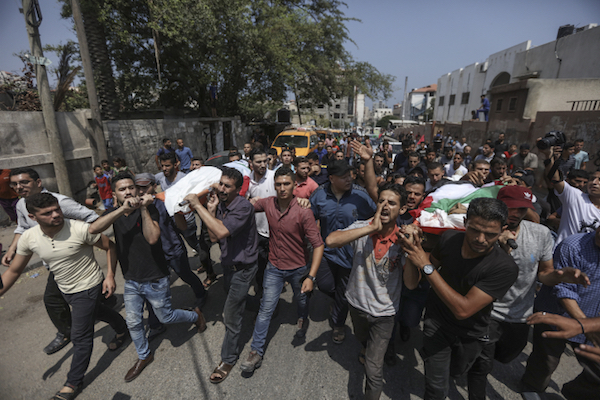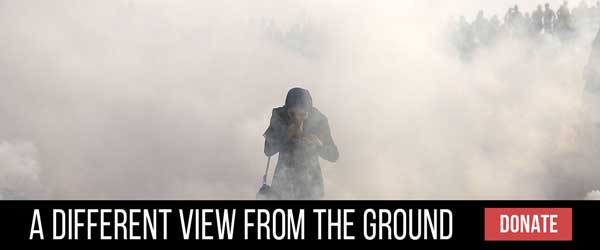The Israeli military published drone footage of its air force bombing a seemingly empty building in Gaza. It left out the part where one of its missiles killed two teens sitting on the roof, independent investigators find.

The Israeli army edited out key footage of a missile strike that killed two Palestinian teenagers sitting on a Gaza rooftop earlier this year, according to an investigation by the UK-based Forensic Architecture institute and Israeli human rights group B’Tselem that was published this week.
In the late afternoon hours of June 14, 2018, two Palestinian teens, Luai Kahil and Amir al-Nimra, climbed to the rooftop of al-Katiba building in Gaza City. The selfie they took on the rooftop that day would be the last photo of the teens.
The Israeli air force launched four “warning missiles” toward the building, which it said was a Hamas training facility. The warning missiles, low-explosive missiles Israeli army calls “roof knocking,” are meant to warn civilians to leave the targeted building before larger bombs are dropped, according to the army.
Following the “warning missiles,” four larger missiles leveled the building. Kahil and al-Nimra, however, were killed by the first of the warning missiles. Twenty-three other Palestinians were wounded by the larger missiles.
On the day of the strike, the Israeli army released footage of the strikes on Twitter, which seemingly show four different “warning strikes” preceding the larger missiles. Based on the B’Tselem and Forensic Architecture investigation, however, it appears that the published video is not congruent with way the events actually unfolded.
Footage of the first strike, in which the boys were killed, was omitted from the montage released by the army. What the army portrayed as the first strike (the army public relations video does not specifically state that they are sequential) is in fact the third warning strike shown from a different camera and angle.
According to B’Tselem and Forensic Architecture, the omission of the footage of the first strike raises the question of whether Israeli military knew the two boys were sitting on the roof of the building when it launched the first missile, and whether it is trying to cover up that fact. (Disclosure: I participated in a previous investigation by Forensic Architecture.)
“Airstrikes in Gaza are marketed to the public by the Israeli military as surgical actions, designed to protect civilians, based on precision intelligence, accurate munitions, state-of-the-art surveillance, and close attention to international law,” Haggai El-Ad, the executive director of B’Tselem, said in a press statement.
“In reality, that is often nothing more than propaganda. The truth, instead, is devastating civilian casualties, surveillance that is incapable of distinguishing combatants from teenagers, inept intelligence, and the reduction of legal principles that are intended to protect civilians into a perfunctory checklist, which is later used to whitewash human rights violations, and to establish impunity,” he added.
Forensic Architecture used an array of imagery in its investigation, including aerial footage released by the Israeli military, CCTV footage captured from nearby cameras, and videos published on social media at the time.
The investigators then synchronized and lined up the materials to reconstruct a simulation of the event. By synchronizing the two videos, one can see that the blasts from the third strike and what the army claims to be the first strike are identical.
“This investigation demonstrates how a deep reading of the imagery provided by the IDF, which was ostensibly intended to legitimise the ‘warning strikes’ on the al-Katibah building, can be unravelled to reveal a different story,” Nicholas Masterton, a researcher and project coordinator at Forensic Architecture, said in a press release.
“The wealth of images and videos in this case allowed us to conduct a rigorous independent investigation, and to challenge the Israeli military’s claims. We could not only show that Kahil and a-Nimrah were killed by a deadly missile, but also expose the underhanded way in which the Israeli military presented details of such strikes to the public,” he added.
An Israeli military spokesperson did not address specific questions about whether or why the video of the first missile strike was left out, mendaciously or not, of the footage released by the army.
Instead, the spokesperson sent the following written statement:
“The IDF attacked a five-story building in the Gaza Strip used by Hamas brigades as a training facility for combat in urban areas. Following the strike, there were claims that it had caused the death of two teens. The incident was investigated, and based on the investigation, it was found that at the time the air strikes were issued, no people were identified on the building’s rooftop. The findings of the investigation are currently being reviewed by the Military Advocate General’s office. We emphasize that prior to the attack, various cautionary steps were taken to minimize civilian casualties as much as possible. A number of missiles with reduced ammunition were fired at the building’s roof, known as ‘roof knocking.’”
A version of this article first appeared in Hebrew on Local Call. Read it here.


